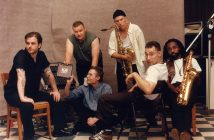As Bob Dylan plugged in to rock’n’roll stardom, many of his fans switched off. 50 years on, Bringing It All Back Home is no less infamous and continues to provide influence.
On 22nd March 1965, Bob Dylan was the poster boy of the folk music scene. Having risen from the cramped, dingy music clubs of Greenwich Village, he would soon be playing back-to-back sell-out shows at the Royal Albert Hall. His music was reaching audiences that the likes of folk royalty such as Pete Seeger and Woody Guthrie could only have dreamed of.

Daniel Kramer’s iconic cover art has been analysed as closely as the music itself thanks to the meticulously planned artifacts that surround Dylan.
Earlier this month, tongues were wagging over Mumford and Sons’ bold move from their recognised acoustic sound. However, although ‘Believe’ may have sparked mild outrage, their trademark style is not completely sullied. When Dylan’s fans let the needle fall on side one of Bringing It All Back Home they must have thought the LP was playing at the wrong speed. The first track, ‘Subterranean Homesick Blues’ opens with a fast paced electric guitar riff which paves the way for the frenzied vocals that follow. Some argue that the song represents a key influence to rap music both in terms of the pacing and the vitriolic political lyrics. He sings, “I’m on the pavement, thinking about the government” and later draws reference to his own catalogue stating, “You don’t need a weatherman to know which way the wind blows”. A further titbit of musical history can be seen in the music video for the song which is viewed as one of the first purpose made examples of the form.
Track two, ‘She Belongs to Me’, is an ode to fellow folk artist Joan Baez with whom the singer was romantically involved at the time. The respect he felt towards Baez is apparent throughout the song and in comparatively mellow tone from the lead track he croons, “She’s nobody’s child, the law can’t touch her at all”. The album takes a monumental shift once again with ‘Maggie’s Farm’. On face value, it’s a raucous blues inspired rock song but if you dig a little deeper, the Civil Rights agenda that Dylan had previously attempted to distance himself from is clear to see. This is apparent as he laments, “I wake up in the morning, fold my hands and pray for rain” and, “They say sing while you slave”. Isolated, the lyrics preach the wrongs of the 19th century slave trade but Dylan situates them within the parenthesis of a stadium rock song. The timeless content of this continues into ‘Love Minus Zero/No Limit’, “In the dime stores and bus stations, people talk of situations, read books, repeat quotations, draw conclusions on the wall”. It’s somewhat hypocritical for me to draw attention to the regurgitation of rhetoric in contemporary society as I write about a fifty year-old record. However, what is clear is that Dylan documents the habitual ills of mankind which have remained unaltered in the last half century.
Ever the contrarian, the second half of his album sees a shift back to the acoustic medium. It opens with one of Dylan’s greatest hits and one of the finest songs ever written, ‘Mr Tambourine Man’. Thanks to The Byrds, he effectively scored his first ever number one as their version topped the charts. The effect of this was to make his own stock rise yet further. Some might think that the jingle jangle mornings and magic swirling ships that the lyrics describe are nonsensical products of an evening of hard drugs. “Take me disappearin’ through the smoke rings of my mind”, seems as blatant an allusion to the narcotics influence as The Beatles’ ‘Lucy in the Sky with Diamonds’ (yes, that’s L.S.D). But this is not the only substance behind the hit. Dylan was a self-confessed fan of the poet Dylan Thomas, on whom his name was partly based. Thomas’ Under Milk Wood speaks of, ‘Noah’s whirring Ark’ and the, ‘sloeblack, slow, black, crowblack, fishingboatbobbing sea’. ‘Mr Tambourine Man’ matches this poetic wordplay with, “to dance beneath the diamond sky with one hand waving free, silhouetted by the sea, circled by the circus sands”. This lyrical style extends to the following songs, ‘The Gates of Eden’ and ‘It’s Alright Ma’.
For me, the latter is the singer’s lyrical masterpiece. The minimal guitar parts only serve to draw attention to words which read like poetry. Statements such as, “Money doesn’t talk it swears” and, “Advertising signs that con you into thinking you’re the one, that do can do what’s never been done, that can win what’s never been won”, are surely only more relevant in the 21st century? Bringing It All Back Home may principally be a pop record, but if you dig a little deeper, you can see a true genius at work.
Bringing It All Back Home was released in March 1965 by Columbia Records.

![Midge Ure on Legacy, Live Aid, and his upcoming ‘Catalogue’ tour: ‘The idea that there could be an [AI] Ultravox in 40/50 years from now is terrifying’](https://theedgesusu.co.uk/wp-content/uploads/2024/03/download-214x140.jpg)


1 Comment
It came out on my 7th birthday, and with its sound encited my rebel vision on the world even before I understood the lyrics, that are full of images but carry a deep meaning as I was soon to learn when I started to try and understand the English language even before it was teached to me at school. My older brother bought it and we were glued to the record player, though the rest of the big christian family loathed the album, and my father would not have it in the same room as him (well, we did not want him near us with his big fists). In a way it is more radical than Highway 61, where the absurd wordplay often just expresses a feeling (but how briliant!), here the poetry relates to things most real in life, prophetic at times. And the music on side one presages punk and rap and has a rock vibe that seems to come straight from the Sun studio anno 54, while the acoustic side is hypnotic rather than folky. It’s allright Ma (I’m only bleeding) is where folkblues rocks at its hardest and lays down the best lyrics I ever heard. Unsurpassed, unprecedented. A world wonder to behold, speaking to us and those that will come after us (I almost fear).